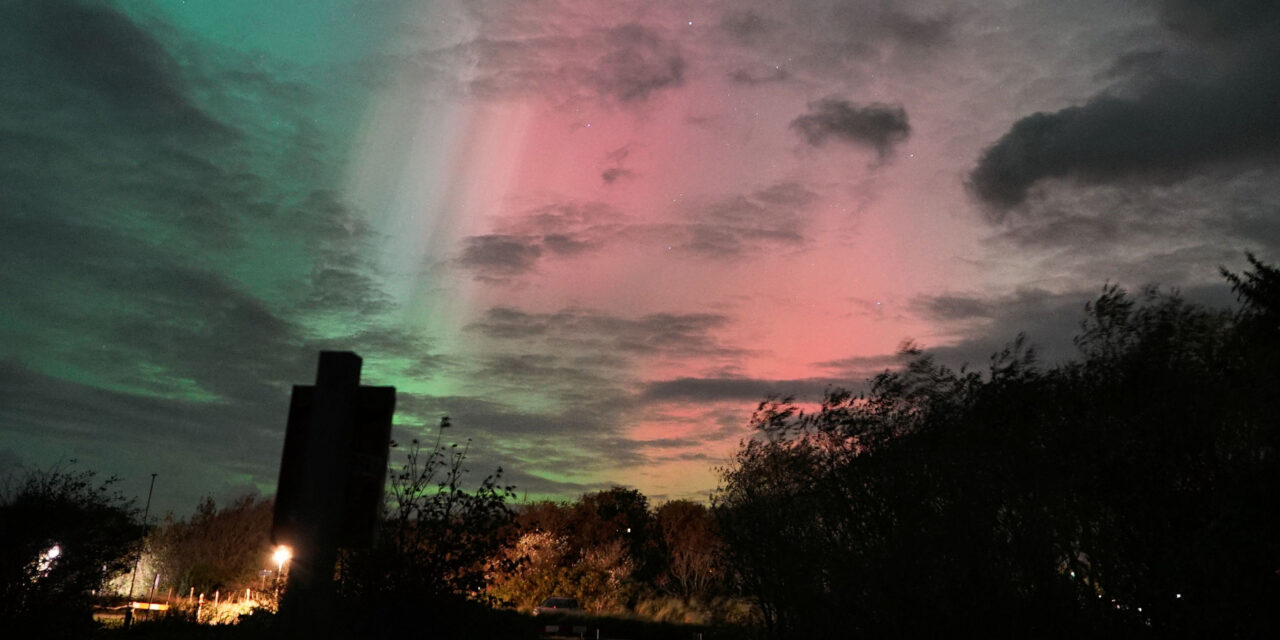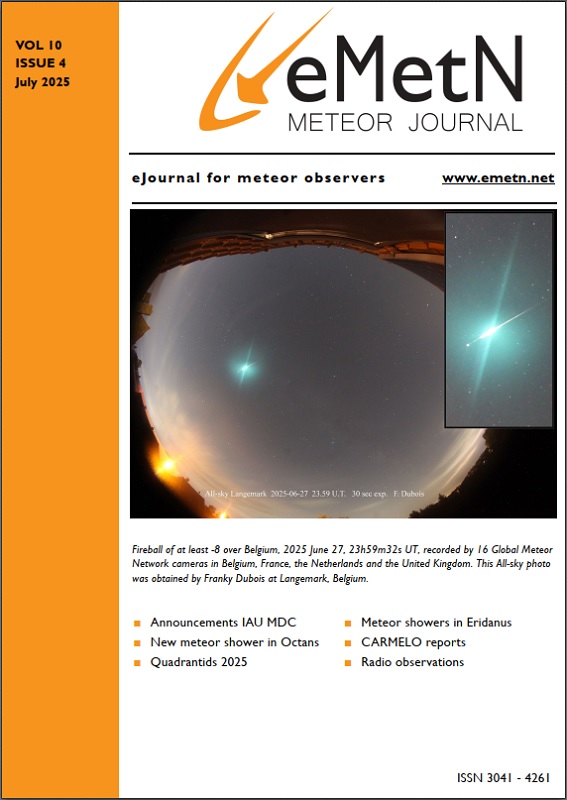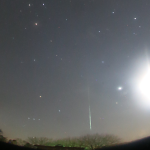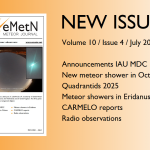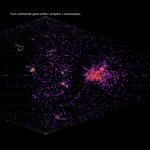Introduction
The second half of September, little could be observed due to moonlight and bad weather. Fortunately, chances of a clear night increased at the beginning of October when a series of clear nights was expected. In July, we booked a late holiday between 4 and 11 October 2024, again on Texel, a Dutch island between the Wadden sea and Northsea. This time we were not at our usual spot in the hamlet of Midden Eierland, about 4 km south of De Cocksdorp. This time we had rented a 4-person house at the Landal holiday park De Sluftervallei, which is about 3 km from the northernmost point of Texel and the lighthouse. Although it was a holiday, I of course also looked at possible locations were I could observe meteors in case of a clear night. The park is not suitable given the lighting and trees. The park is somewhat hidden in the woods and there were enough dark locations with SQM values above 21 within walking distance.
As early as October 2, the sky began to clear and the first observations could be made from the “meteor roof” on the dormer at home.
October 2/3, 2024
After a short night’s sleep I checked the weather: the sky is clear! The sky is very transparent, the limiting magnitude is 6.3. The SQM values were slightly disappointing with 20.34 as a maximum and the temperature dropped from 4 to 0 degrees Celsius. The observations started at 00:15 and ended at 03:50 UT, effectively exactly 3.5 hours. Thanks to the transparency, a fair number of meteors were seen, hourly counts increased to 11, 13, 15 and 6 (half hour) respectively. Of these, there were 2 southern Taurids (STA), 0 northern Taurids (NTA), 0 October Camelopardalids (OCT), 6 delta Aurigids (DAU) and 4 early Orionids. Few bright meteors, but a fireball was seen! A fast sporadic (SPO) -4 fireball appeared in Gemini at 02:32 UT and left a 4-second trail. A little earlier, a slow magnitude 0 SPO appeared in the Ursa Minor.
October 3/4, 2024
Another clear night. It was decided to have a somewhat shorter session because we would also travel to Texel today. Observations took place between 00:57 and 03:36 UT. The conditions are the same as the previous night. Maximum SQM 20.32 and limiting magnitude 6.3. Nevertheless, the hourly counts were lower than the previous night with 7, 10 and 8 (0.6 hours) per hour respectively. A total of 25 meteors of which 3 ORI, 4 STA and 1 DAU. Again, few bright meteors, an Orionid of +1 in Pegasus was the brightest. Incidentally, the observations were briefly disturbed by the well-known blue light column of ProRail, a train with a huge blue beam of light directed upwards to check the overhead lines of the track. Again the temperature dropped to 0 degrees Celsius. Also a part of a Starlink train passed by with satellites with a maximum magnitude of +2.
October 4/5, 2024
After arriving and settled at the holiday park de Sluftervallei, I took a walk along the Krimweg. There were plenty of spots there, but I was wary of cars passing by. On the way back I saw a cycle path that went into the dunes to the left of the Krimweg. There I walked a bit where you immediately went up a high dune. Just behind the dune top was a flat piece of grassland/star moss. Yes, this will be the observation location, the lighthouse nicely behind the dune top and a good view in all directions.
After a short sleep I woke up at 23:50 UT: sky is clear, so I quickly got dressed and went to the dunes. The observations started at 00:16 UT. The sky was crystal clear with a limiting magnitude of 6.6 and an SQM of 21.30. The sky was perfect up to 10 degrees altitude, but in an easterly direction the sky background was a bit lighter due to the holiday parks. And in a southerly direction a light dome up to 20 degrees altitude of the city Den Helder at the main land and the greenhouses behind it was visible. I have been visiting Texel for over 14 years now and I see that the light pollution has increased considerably in that direction. During the session the sky became a bit hazier below 20 degrees, perhaps due to the warm sea water in combination with the cold air? I positioned myself in a south-easterly direction so that I was not too disturbed by the lighthouse. A few times I looked to the north because the northern lights were also expected after a heavy X9.1 explosion on the sun a few days earlier. It also became cold, the wind was almost absent and the temperature eventually dropped to 0 degrees Celsius. Observations were carried out between 00:16 and 04:21 UT, exactly 4 hours of effective observation time. The limiting magnitude gradually dropped from 6.6 to 6.4. Thanks to the high transparency the hourly counts were very nice with 18, 16, 23 and 12 meteors respectively. Of these there were 5 Orionids (max 3 per hour), 5 STA, 2 OCT, 1 DRA and 1 EGE. Again a lot of weak stuff and a few bright meteors. For example there was a fast possible October Camelopardalid of magnitude 0 with 2 seconds of a persistent trauin and a +1 SPO in Monoceros at 02:28 UT. However the most beautiful meteor was, thanks to another aurora inspection, on the northern horizon. A very slow earthgrazer moving from Canes Venatici just under the star Alkaid and extinguishing just under the head of the Dragon. The meteor showed a wake and fragmented into two pieces. t’s these kinds of appearances that make a session worthwhile. Around 03:15 UT I see a first hint of the zodiacal light. Half an hour later it is clearly visible from Leo to Cancer, with the best visibility around 4 UT. After that it quickly disappears again in the upcoming twilight. All in all a very nice session!
October, 5/6 2024
In the evening, the cumulus clouds quickly dissolved again and the sky became clear again. There was a chance that I would have to stop earlier with the approaching front. Observations were done between 23:58 and 03:07 UT, exactly 3 hours effective. The entire session there was a varying amount of cirrus visible in the southwest, but as it came closer the cirrus clouds dissolved. Ultimately, the session is terminated when the cirrus finally enters my field of view.
The sky was slightly less than the previous night with a maximum limiting magnitude of 6.5 and SQM 21.20. Hourly counts of 10, 14 and 14. A total of 38 meteors of which 3 ORI, 6 STA, 5 DAU, 2 OCT, 1 EGE and 0 DRA (low radiant position). Again, only a few bright meteors. A +2 DAU with short persistent train in Auriga and at 02:15 UT a +1 SPO in the Big Dipper. However, the highlight was at the end of the session at 02:57 UT. A beautiful magnitude -1 orange teardrop-shaped STA moved from Gemini via Cancer to the crescent of Leo where it ended in a final flare of -2. A nice end to the session!
October 6/7, 2024 was completely cloudy with rain at night. That didn’t matter because after 4 nights I had to get some sleep.
October 7, 2024 in the evening: Aurora!
With some delay, the CME of the X9.1 explosion on the sun of October 3rd arrived. At first, nothing seemed to happen, but after a report on a Dutch site about weather (weerwoord.nl) that there might be aurora to be seen, I looked outside. There are some clearings, but with clouds coming in from the west. I quickly walked 10 minutes to the dark location. In a large gap in the clouds, the Big Dipper and surroundings are visible. A grayish light band is visible in it. Cirrus or Northern Lights? Suddenly, a number of very fine lines appear in the luminous band, which then also clearly turned reddish. Unfortunately, the clouds quickly make the clearing smaller. What to do? I quickly got a camera, but back on location it was largely overcast. Low northwest, an elongated clearing that turned greenish is visible. The images from the camera indeed confirm that it is aurora.
October 8/9: Draconids active (well a bit…)!
The 2024 IMO Meteor Calendar stated that on October 8 between 6 and 7 UT the Earth would pass through a few old dust trails of comet 21P/Giacobini-Zinner. Indeed, the author received a message via Messenger around 11:30 UT from the Canadian meteor observer Pierre Martin that he had seen a number of Draconids despite low radiant position (and aurora!). This message gave me extra energy to do something in the evening hours. It looked like that in the evening the sky would became clear for 2 or 3 hours before the clouds moved in again.
In the evening twilight I walked to the observation location and I signed on at 18:28 UT. There was still some twilight but the limiting magnitude was already at 6.3 and quickly rose further to 6.5. At the end of the session the limiting magnitude dropped a bit to 6.4. SQM remained around 21.02. Transparency is good and I am looking in a north-northwesterly direction. Observations were possible until 20:31 UT when some clouds move into the field of view. Some lightning is also visible from thunderstorms off the English coast. In those two hours, 14 meteors are counted, of which 2 were Draconids, 1 in each hour. Both were of magnitude +3. The first appeared just below the duo Alcor/Mizar with a short trail. The second appeared slightly to the right of the imaginary line between the stars ksi and beta Hercules.
Again, a fragmenting +2 SPO earthgrazer was seen, this time from beta Bootes to Alkaid (epsilon UMA). And at the end a fast magnitude -1 blue-yellow SPO with a 4-second persistent train. This was also the last meteor observed from Texel this year.
October 10/11, 2024: A beautiful aurora display!
On October 8, 2024 at 01:56 Universal Time (03:56 local time), sunspot 3848 caused a powerful explosion. It was a flare of the most powerful kind, this time an X1.8. This explosion lasted four hours and caused a large CME (Coronal Mass Ejection) in which a cloud of particles was blown from the sun’s surface into space. The CME was aimed exactly at Earth and NOAA and NASA models predicted that the cloud of particles would reach the Earth’s atmosphere on October 10 around 14 UT (16:00 local time) with a high probability of a geomagnetic storm and bright aurora.
Indeed, on October 10, 2024 at 15:15 UT (17:15 local time) the CME hit Earth. In no time, reports of bright aurora were coming in. The author was geographically very well positioned to see the aurora: 53 north and a dark sky. The disadvantage was the weather. As soon as it got dark, it remained mostly cloudy with occasional rainshowers. Only at 18:48 UT (20:48 local time) there were a few small clearings in the north. But those clearings looked greenish!
On SAT 24 I kept an eye on the cloud pictures. Around 20:35 UT some small clearings arrived at my location and I took a short walk to the observation location, this time with camera and tripod (a Sony Alpha A7 S II camera with a Sigma 20mm F/1.4 DG HSM ART lens controlled by a HAMA DCCS timer).
Despite the ample cloud cover, the greenish glow was clearly visible, as well as the rapid emergence of red streamers in the northeast. This was all beautifully seen and photographed between 20:40 and 21:00 UT (22:40 and 23 local time). Despite the fact that it was almost completely cloudy around 21 UT, I could still see bright red glow behind the clouds. Then quickly inside for approaching rainshowers.
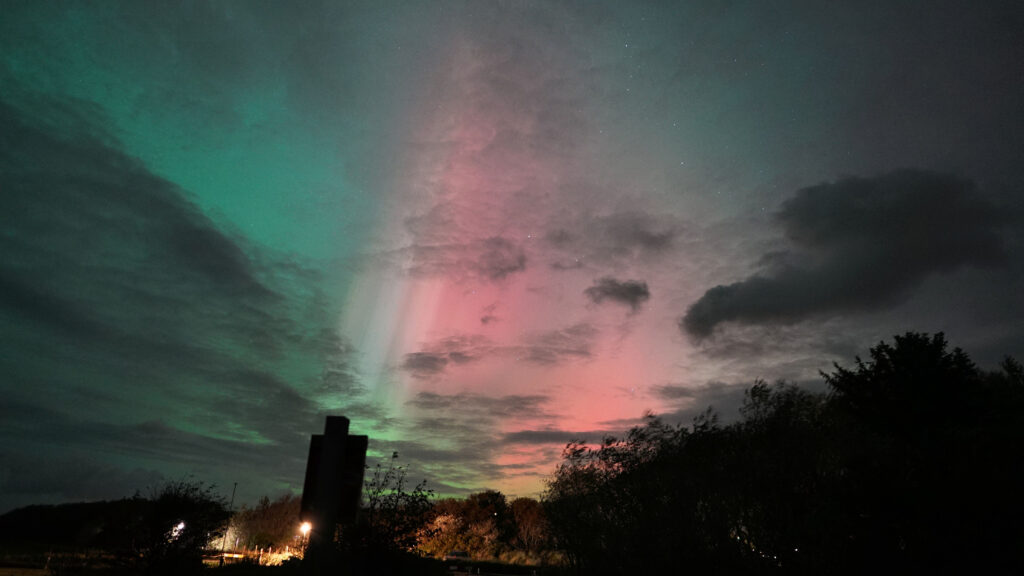
Figure 1. Aurora on October 10, 2024 at 20:46 UT from the edge of the Landal park. Camera: Sony Alpha A7 II7 with Sigma 20mm f/1.4 DG DN Art lens.
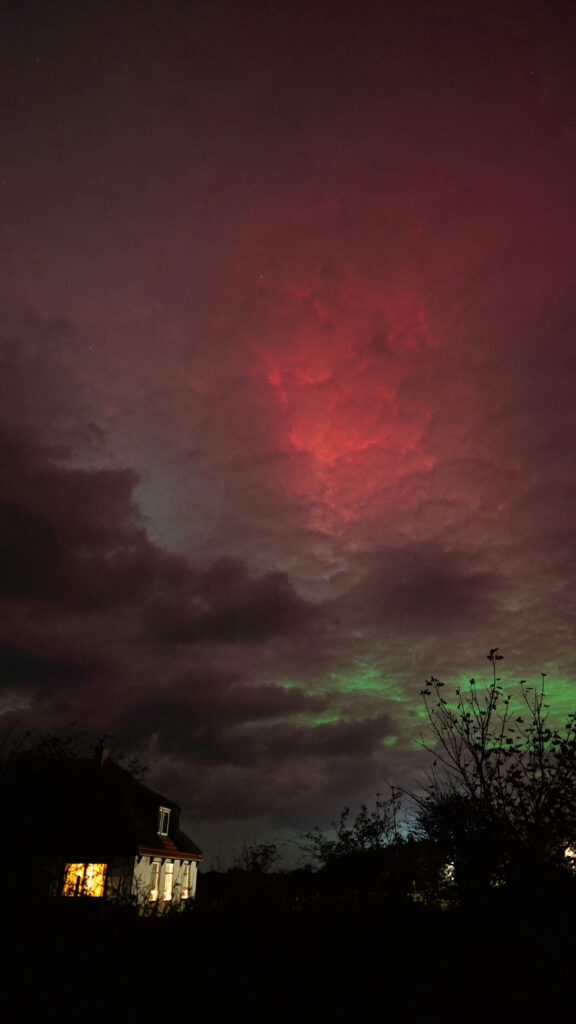
Figure 2. Aurora visible through the cumulus clouds on October 10, 2024 at 21:55 UT. Camera: Sony Alpha A7 II7 with Sigma 20mm f/1.4 DG DN Art lens.
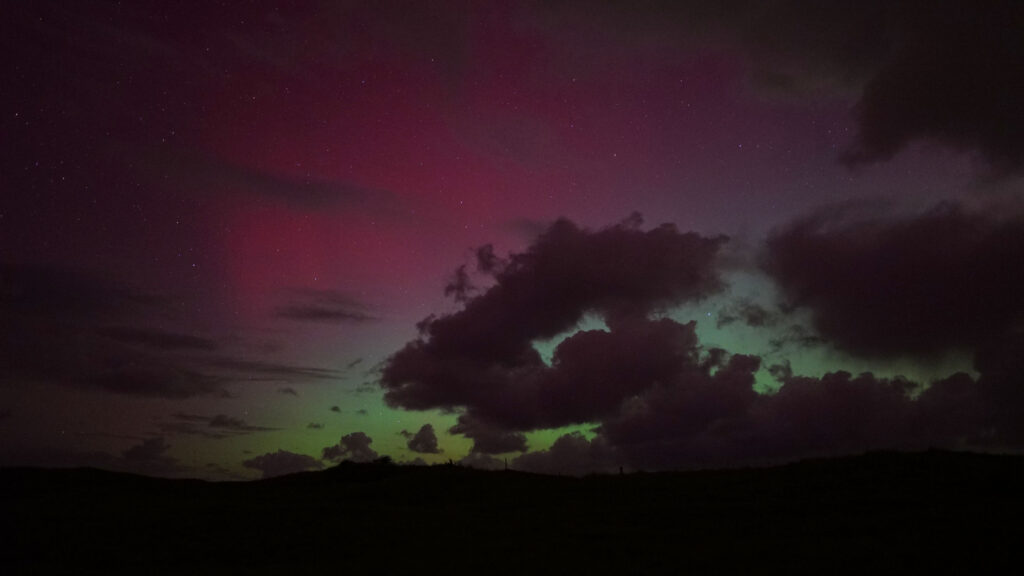
Figure 3. Aurora on October 10, 2024 at 21:39 UT as seen from the observing site. Camera: Sony Alpha A7 II7 with Sigma 20mm f/1.4 DG DN Art lens.
Shortly afterwards I was able to return to the dark location and beautiful shots were taken of green and red aurora borealis. Sometimes there were rainshowers visible at some distance and it was clear above me and yet it was raining! The wind was so strong that the drops blew away from under the storms. Around 23:00 UT there was a big revival in the aurora borealis. I checked the sky again after a few rainshowers and large parts of the sky was bright red! A shot of it was taken at 23:35 UT. A minute later another photo was taken with exactly the same camera settings and the aurora borealis was already a lot less bright.
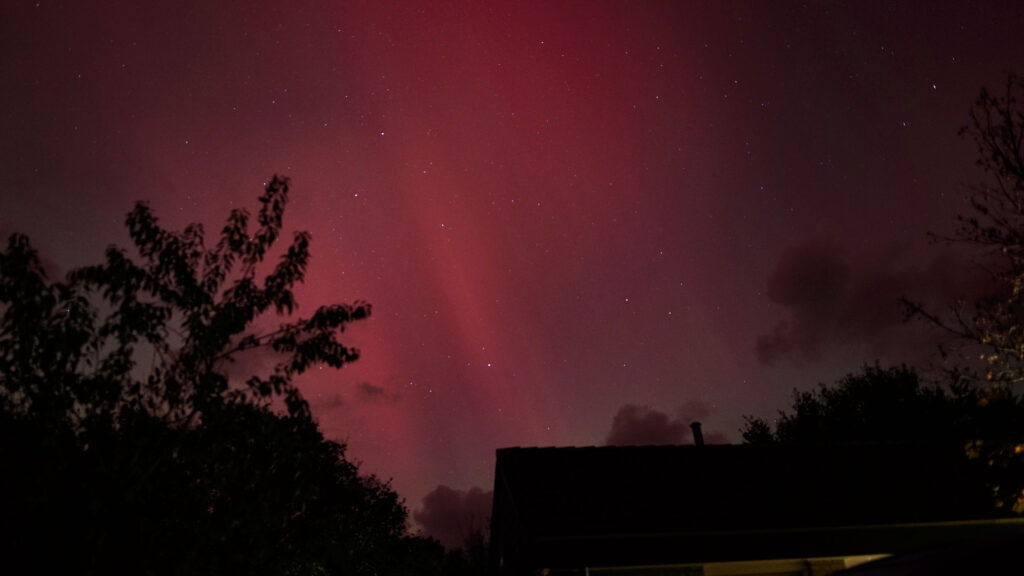
Figure 4. Aurora on October 10, 2024 at 23:36 UT at our rented house.
Camera: Sony Alpha A7 II7 with Sigma 20mm f/1.4 DG DN Art lens.
At 00:30 UT there was less activity and I decided to finally get some sleep. I heard from friends that the aurora borealis had been active all night. This aurora borealis observation will definitely be in my top 5. A very nice end of our holiday!
November 02/03, 2024
A nice 3.5 hour session under good transparent conditions, with the limiting magnitude lagging behind again. Observations were made between 00:40 and 04:15 UT and that yielded 43 meteors of which 10 Orionids, 4 southern and 2 Northern Taurids. An early Leonid was also spotted. The brightest meteors were a 0 STA, 1 NTA and a 0 and +1 SPO.
November 03/04, 2024
A somewhat hazy and misty night with the limiting magnitude fluctuating between 6.0 and 6.1. Between 01:34 and 04:36 UT 29 meteors were counted. An early -1 Leonid and -1 SPO were the most beautiful meteors seen.
After these two sessions bad weather sets in. The month of December 2024 was one of the cloudiest ever in the Netherlands. The Geminid (and Ursid) maximum took place under gray skies. In the evening of December 14th sky cleared up a partly, but no observations were made.

